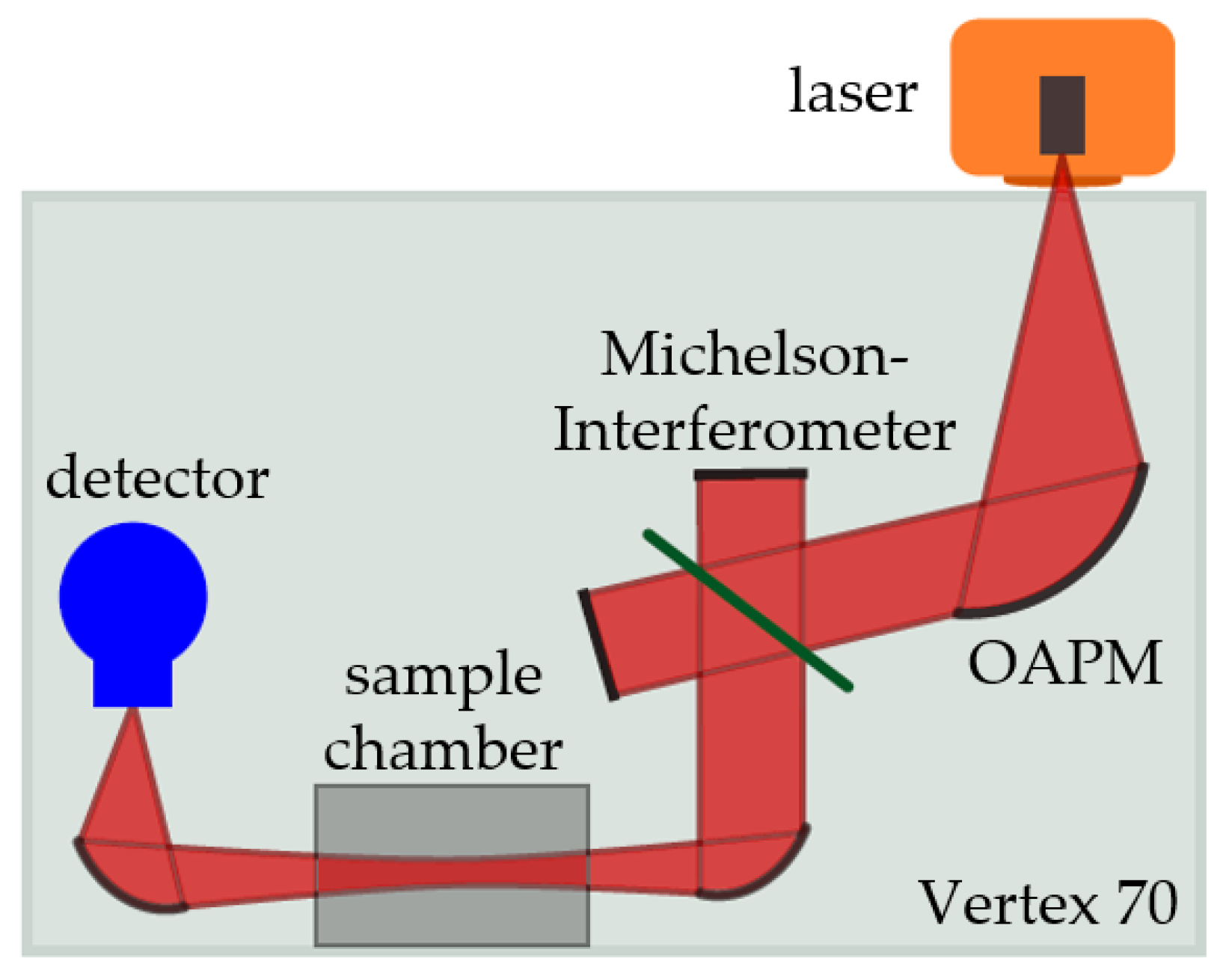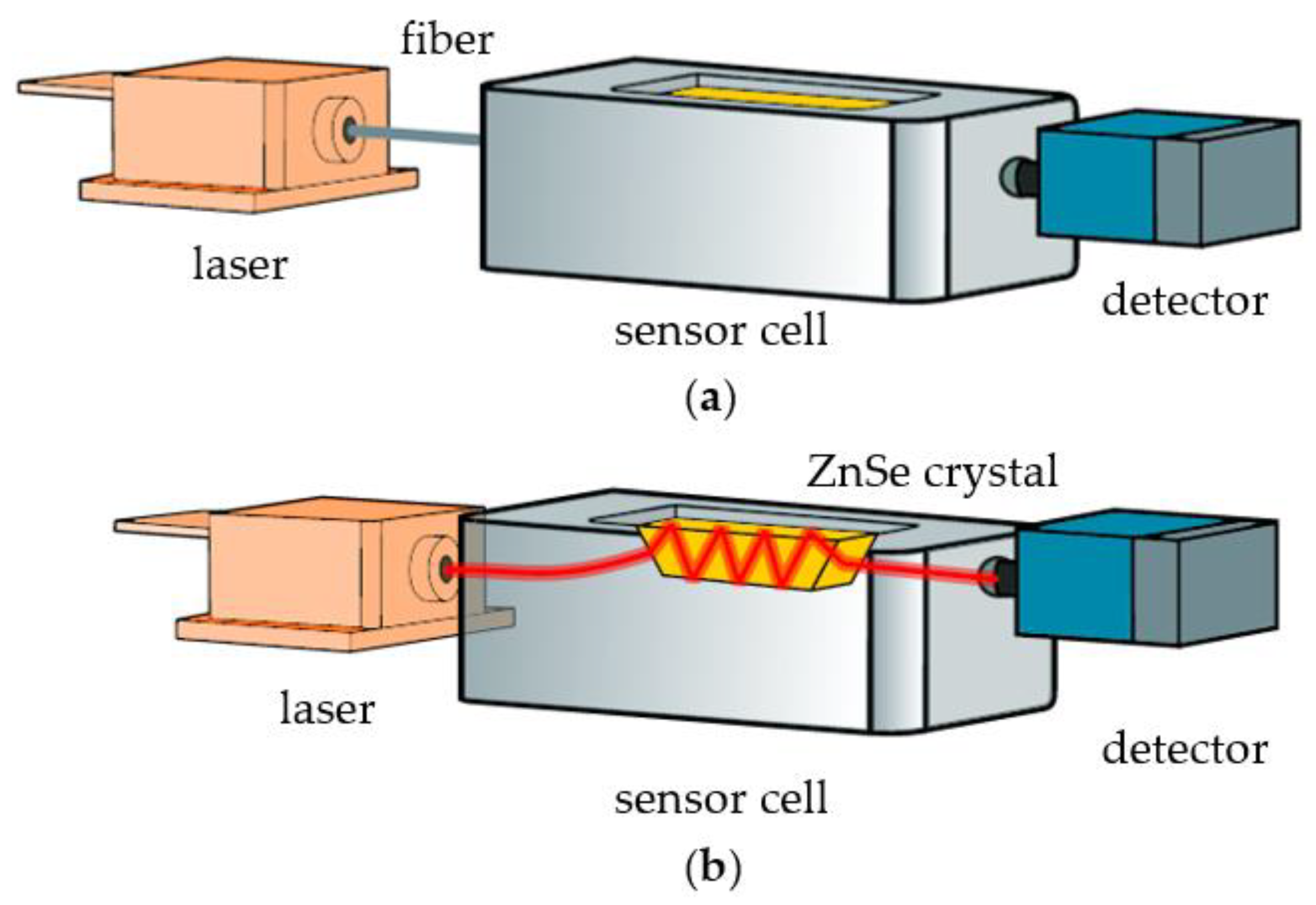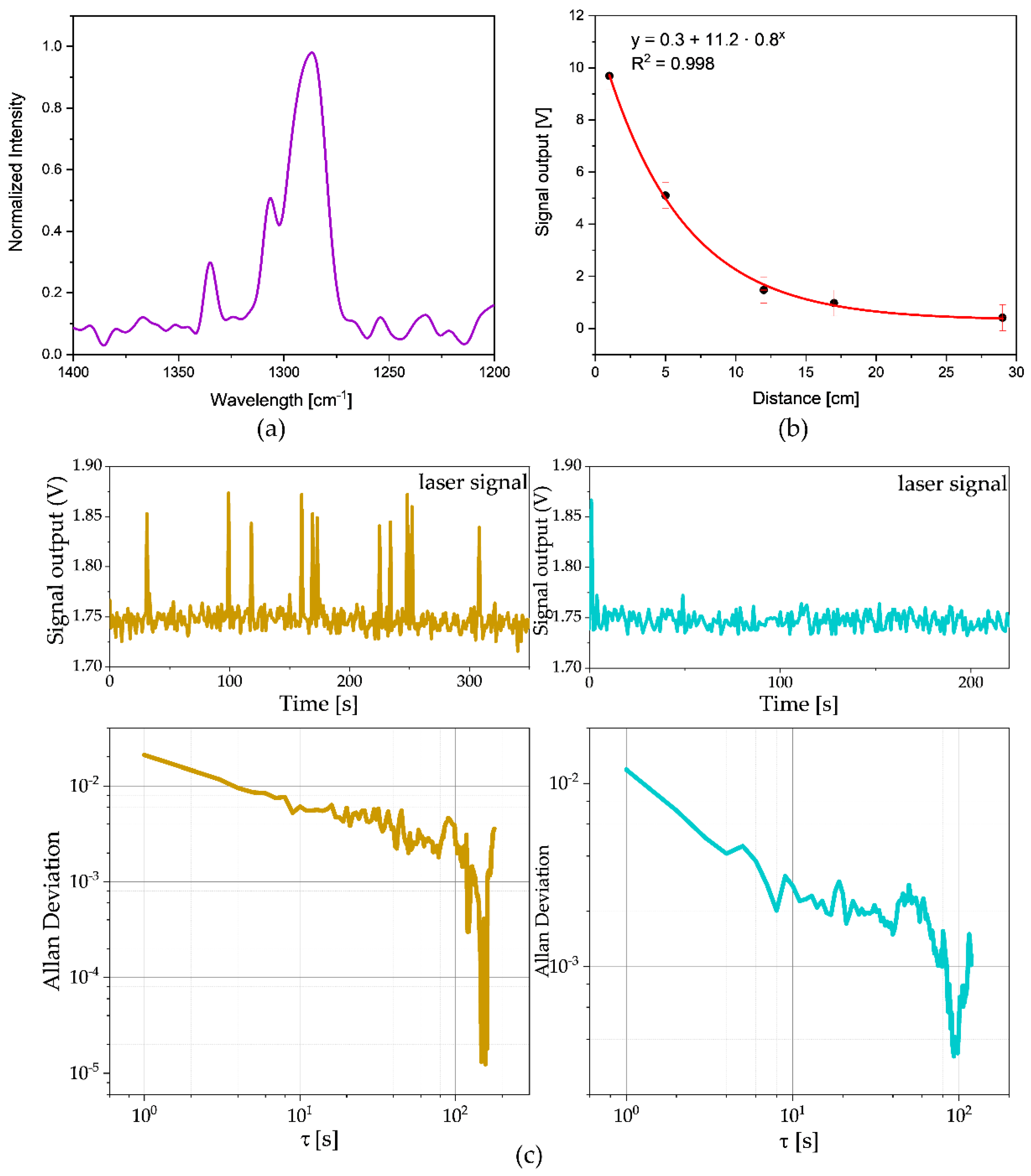RobustATR: Substrate-Integrated Hollow Waveguide Coupled Infrared Attenuated Total Reflectance Sensors
Abstract
Featured Application
Abstract
1. Introduction
2. Materials and Methods
3. Results and Discussion
3.1. QCL Characterization
3.2. QCL Coupled to the RobustATR Assembly with and without Hollow-Core Fiber
4. Conclusions
Author Contributions
Funding
Institutional Review Board Statement
Informed Consent Statement
Data Availability Statement
Acknowledgments
Conflicts of Interest
References
- Kuráň, P.; Soják, L. Environmental analysis of volatile organic compounds in water and sediment by gas chromatography. J. Chromatogr. A 1996, 733, 119–141. [Google Scholar] [CrossRef]
- Stach, R.; Pejcic, B.; Crooke, E.; Myers, M.; Mizaikoff, B. Mid-infrared spectroscopic method for the identification and quantification of dissolved oil components in marine environments. Anal. Chem. 2015, 87, 12306–12312. [Google Scholar] [CrossRef] [PubMed]
- Heath, C.; Myers, M.; Pejcic, B. The effect of pressure and temperature on mid-infrared sensing of dissolved hydrocarbons in water. Anal. Chem. 2017, 89, 13391–13397. [Google Scholar] [CrossRef] [PubMed]
- Sumaila, U.R.; Cisneros-Montemayor, A.M.; Dyck, A.; Huang, L.; Cheung, W.; Jacquet, J.; Kleisner, K.; Lam, V.; McCrea-Strub, A.; Swartz, W.; et al. Impact of the deepwater horizon well blowout on the economics of US gulf fisheries. Can. J. Fish. Aquat. Sci. 2012, 69, 499–510. [Google Scholar] [CrossRef]
- Pejcic, B.; Eadington, P.; Ross, A. Environmental monitoring of hydrocarbons: A chemical sensor perspective. Environ. Sci. Technol. 2007, 41, 6333–6342. [Google Scholar] [CrossRef]
- Chen, H.; Buric, M.; Ohodnicki, P.R.; Nakano, J.; Liu, B.; Chorpening, B.T. Review and perspective: Sapphire optical fiber cladding development for harsh environment sensing. Appl. Phys. Rev. 2018, 5, 011102. [Google Scholar] [CrossRef]
- Ghosh, A.; Zhang, C.; Shi, S.Q.; Zhang, H. High-temperature gas sensors for harsh environment applications: A review. CLEAN Soil Air Water 2019, 47, 1800491. [Google Scholar] [CrossRef]
- Leifer, I.; Lehr, W.J.; Simecek-Beatty, D.; Bradley, E.; Clark, R.; Dennison, P.; Hu, Y.; Matheson, S.; Jones, C.E.; Holt, B.; et al. State of the art satellite and airborne marine oil spill remote sensing: Application to the BP deepwater horizon oil spill. Remote Sens. Environ. 2012, 124, 185–209. [Google Scholar] [CrossRef]
- Beyer, J.; Trannum, H.C.; Bakke, T.; Hodson, P.V.; Collier, T.K. Environmental effects of the deepwater horizon oil spill: A review. Mar. Pollut. Bull. 2016, 110, 28–51. [Google Scholar] [CrossRef]
- Schädle, T.; Pejcic, B.; Myers, M.; Mizaikoff, B. Fingerprinting oils in water via their dissolved VOC pattern using mid-infrared sensors. Anal. Chem. 2014, 86, 9512–9517. [Google Scholar] [CrossRef]
- Pérez-Caballero, G.; Andrade, J.M.; Muniategui, S.; Prada, D. Comparison of single-reflection near-infrared and attenuated total reflection mid-infrared spectroscopies to identify and monitor hydrocarbons spilled in the marine environment. Anal. Bioanal. Chem. 2009, 395, 2335–2347. [Google Scholar] [CrossRef] [PubMed]
- Fingas, M.F.; Brown, C.E. Review of oil spill remote sensing. Spill Sci. Technol. Bull. 1997, 4, 199–208. [Google Scholar] [CrossRef]
- Joe, H.-E.; Yun, H.; Jo, S.-H.; Jun, M.B.G.; Min, B.-K. A review on optical fiber sensors for environmental monitoring. Int. J. Precis. Eng. Manuf. Technol. 2018, 5, 173–191. [Google Scholar] [CrossRef]
- Daham, B.; Andrews, G.E.; Li, H.; Ballesteros, R.; Bell, M.C.; Tate, J.; Ropkins, K. Application of a portable FTIR for measuring on-road emissions. In Proceedings of the SAE 2005 World Congress & Exhibition, Detroit, MI, USA, 11–14 April 2005. [Google Scholar] [CrossRef]
- Lieberzeit, P.A.; Dickert, F.L. Sensor technology and its application in environmental analysis. Anal. Bioanal. Chem. 2006, 387, 237–247. [Google Scholar] [CrossRef]
- Teuber, A.; Stach, R.; Haas, J.; Mizaikoff, B. Innovative substrate-integrated hollow waveguide coupled attenuated total reflection sensors for quantum cascade laser based infrared spectroscopy in harsh environments. Appl. Spectrosc. 2021, 76, 000370282110643. [Google Scholar] [CrossRef]
- Lynd, L.R. Overview and evaluation of fuel ethanol from cellulosic biomass: Technology, economics, the environment, and policy. Annu. Rev. Energy Environ. 1996, 21, 403–465. [Google Scholar] [CrossRef]
- Goldsworthy, L. Fumigation of a heavy duty common rail marine diesel engine with ethanol-water mixtures. Exp. Therm. Fluid Sci. 2013, 47, 48–59. [Google Scholar] [CrossRef]
- Ueno, Y.; Kurano, N.; Miyachi, S. Ethanol production by dark fermentation in the marine green alga, Chlorococcum littorale. J. Ferment. Bioeng. 1998, 86, 38–43. [Google Scholar] [CrossRef]
- Sudhakar, M.P.; Jegatheesan, A.; Poonam, C.; Perumal, K.; Arunkumar, K. Biosaccharification and ethanol production from spent seaweed biomass using marine bacteria and yeast. Renew. Energy 2017, 105, 133–139. [Google Scholar] [CrossRef]
- Iaquaniello, G.; Centi, G.; Salladini, A.; Palo, E. Methanol economy: Environment, demand, and marketing with a focus on the waste-to-methanol process. In Methanol; Elsevier: Amsterdam, The Netherlands, 2018; pp. 595–612. [Google Scholar]
- Zhen, X.; Wang, Y. An overview of methanol as an internal combustion engine fuel. Renew. Sustain. Energy Rev. 2015, 52, 477–493. [Google Scholar] [CrossRef]
- Tütüncü, E.; Nägele, M.; Becker, S.; Fischer, M.; Koeth, J.; Wolf, C.; Köstler, S.; Ribitsch, V.; Teuber, A.; Gröger, M.; et al. Advanced photonic sensors based on interband cascade lasers for real-time mouse breath analysis. ACS Sens. 2018, 3, 1743–1749. [Google Scholar] [CrossRef] [PubMed]
- Le Floc’h, N.; Otten, W.; Merlot, E. Tryptophan metabolism, from nutrition to potential therapeutic applications. Amino Acids 2011, 41, 1195–1205. [Google Scholar] [CrossRef]
- Comai, S.; Bertazzo, A.; Brughera, M.; Crotti, S. Tryptophan in health and disease. In Advances in Clinical Chemistry; Elsevier: Amsterdam, The Netherlands, 2020; pp. 165–218. [Google Scholar]
- Sainio, E.-L.; Pulkki, K.; Young, S.N. L-Tryptophan: Biochemical, nutritional and pharmacological aspects. Amino Acids 1996, 10, 21–47. [Google Scholar] [CrossRef] [PubMed]
- Lu, R.; Sheng, G.; Li, W.; Yu, H.; Raichlin, Y.; Katzir, A.; Mizaikoff, B. IR-ATR chemical sensors based on planar silver halide waveguides coated with an ethylene/propylene copolymer for detection of multiple organic contaminants in water. Angew. Chem. 2013, 125, 2321–2324. [Google Scholar] [CrossRef]
- Bak, J.; Clausen, S. FTIR emission spectroscopy methods and procedures for real time quantitative gas analysis in industrial environments. Meas. Sci. Technol. 2002, 13, 150–156. [Google Scholar] [CrossRef]
- Pejcic, B.; Myers, M.; Ross, A. Mid-infrared sensing of organic pollutants in aqueous environments. Sensors 2009, 9, 6232–6253. [Google Scholar] [CrossRef]
- Mizaikoff, B. Mid-infrared evanescent wave sensors—A novel approach for subsea monitoring. Meas. Sci. Technol. 1999, 10, 1185–1194. [Google Scholar] [CrossRef]
- Gabriel, J.-C.P. A promising portable tool for the continuous, online, and field monitoring of pressured processes. ACS Cent. Sci. 2016, 2, 188–189. [Google Scholar] [CrossRef][Green Version]
- Walsh, J.E.; MacCraith, B.D.; Meaney, M.; Vos, J.G.; Regan, F.; Lancia, A.; Artjushenko, S. Sensing of chlorinated hydrocarbons and pesticides in water using polymer coated mid-infrared optical fibres. Analyst 1996, 121, 789. [Google Scholar] [CrossRef]
- Blommaerts, N.; Dingenen, F.; Middelkoop, V.; Savelkouls, J.; Goemans, M.; Tytgat, T.; Verbruggen, S.W.; Lenaerts, S. Ultrafast screening of commercial sorbent materials for VOC adsorption using real-time FTIR spectroscopy. Sep. Purif. Technol. 2018, 207, 284–290. [Google Scholar] [CrossRef]
- Jung, M.R.; Horgen, F.D.; Orski, S.V.; Rodriguez, C.V.; Beers, K.L.; Balazs, G.H.; Jones, T.T.; Work, T.M.; Brignac, K.C.; Royer, S.-J.; et al. Validation of ATR FT-IR to identify polymers of plastic marine debris, including those ingested by marine organisms. Mar. Pollut. Bull. 2018, 127, 704–716. [Google Scholar] [CrossRef] [PubMed]
- Kim, S.-S.; Young, C.; Mizaikoff, B. Miniaturized mid-infrared sensor technologies. Anal. Bioanal. Chem. 2008, 390, 231–237. [Google Scholar] [CrossRef] [PubMed]
- Haas, J.; Catalán, E.V.; Piron, P.; Karlsson, M.; Mizaikoff, B. Infrared spectroscopy based on broadly tunable quantum cascade lasers and polycrystalline diamond waveguides. Analyst 2018, 143, 5112–5119. [Google Scholar] [CrossRef] [PubMed]
- Griffiths, P.R. Fourier Transform Infrared Spectrometry: Theory and Instrumentation. In Transform techniques in chemistry; Springer: New York, NY, USA, 1978; pp. 109–139. [Google Scholar]
- Tittel, F.K.; Richter, D.; Fried, A. Mid-infrared laser applications in spectroscopy. In Solid-State Mid-Infrared Laser Sources; Springer: Berlin/Heidelberg, Germany, 2003; pp. 458–529. [Google Scholar]
- Stach, R.; Mizaikoff, B. Fuel performance specifications, mid-infrared analysis of. In Encyclopedia of Analytical Chemistry; John Wiley & Sons, Ltd: Chichester, UK, 2017; pp. 1–16. ISBN 9780470027318. [Google Scholar]
- Rassel, S.; Xu, C.; Zhang, S.; Ban, D. Noninvasive blood glucose detection using a quantum cascade laser. Analyst 2020, 145, 2441–2456. [Google Scholar] [CrossRef] [PubMed]
- Schwaighofer, A.; Brandstetter, M.; Lendl, B. Quantum cascade lasers (QCLs) in biomedical spectroscopy. Chem. Soc. Rev. 2017, 46, 5903–5924. [Google Scholar] [CrossRef] [PubMed]
- Teuber, A.; Mizaikoff, B. Cascade Laser Infrared Spectroscopy. In Encyclopedia of Analytical Chemistry; Wiley: Hoboken, NJ, USA, 2021; pp. 1–45. [Google Scholar]
- Patel, C.K.N. Advances in Fabry-Perot and tunable quantum cascade lasers. In Proceedings of the Micro- and Nanotechnology Sensors, Systems, and Applications IX, Anaheim, CA, USA, 11–14 September 2017. [Google Scholar]
- Harrick, N.J. Total internal reflection and its application to surface studies. Ann. N. Y. Acad. Sci. 1963, 101, 928–959. [Google Scholar] [CrossRef]
- Fahrenfort, J. Attenuated total reflection. Spectrochim. Acta 1961, 17, 698–709. [Google Scholar] [CrossRef]
- Averett, L.A.; Griffiths, P.R.; Nishikida, K. Effective path length in attenuated total reflection spectroscopy. Anal. Chem. 2008, 80, 3045–3049. [Google Scholar] [CrossRef]
- Wilk, A.; Chance Carter, J.; Chrisp, M.; Manuel, A.M.; Mirkarimi, P.; Alameda, J.B.; Mizaikoff, B. Substrate-integrated hollow waveguides: A new level of integration in mid-infrared gas sensing. Anal. Chem. 2013, 85, 11205–11210. [Google Scholar] [CrossRef]
- Haas, J.; Stach, R.; Sieger, M.; Gashi, Z.; Godejohann, M.; Mizaikoff, B. Sensing chlorinated hydrocarbons via miniaturized GaAs/AlGaAs thin-film waveguide flow cells coupled to quantum cascade lasers. Anal. Methods 2016, 8, 6602–6606. [Google Scholar] [CrossRef]
- Szczęsna, A.; Skurowski, P.; Lach, E.; Pruszowski, P.; Pęszor, D.; Paszkuta, M.; Słupik, J.; Lebek, K.; Janiak, M.; Polański, A.; et al. Inertial motion capture costume design study. Sensors 2017, 17, 612. [Google Scholar] [CrossRef] [PubMed]
- Wang, L.; Zhang, C.; Gao, S.; Wang, T.; Lin, T.; Li, X. Application of fast dynamic allan variance for the characterization of FOGs-based measurement while drilling. Sensors 2016, 16, 2078. [Google Scholar] [CrossRef] [PubMed]
- Riley, W.; Howe, D. Handbook of Frequency Stability Analysis; NIST: Gaithersburg, MD, USA, 2008. [Google Scholar]
- Allan, D.W. Statistics of atomic frequency standards. Proc. IEEE 1966, 54, 221–230. [Google Scholar] [CrossRef]
- Werle, P.; Mücke, R.; Slemr, F. The limits of signal averaging in atmospheric trace-gas monitoring by tunable diode-laser absorption spectroscopy (TDLAS). Appl. Phys. B Photophysics Laser Chem. 1993, 57, 131–139. [Google Scholar] [CrossRef]
- Plyler, E.K. Infrared spectra of methanol, ethanol, and n-propanol. J. Res. Natl. Bur. Stand. 1952, 48, 281. [Google Scholar] [CrossRef]




Publisher’s Note: MDPI stays neutral with regard to jurisdictional claims in published maps and institutional affiliations. |
© 2022 by the authors. Licensee MDPI, Basel, Switzerland. This article is an open access article distributed under the terms and conditions of the Creative Commons Attribution (CC BY) license (https://creativecommons.org/licenses/by/4.0/).
Share and Cite
Teuber, A.; Mizaikoff, B. RobustATR: Substrate-Integrated Hollow Waveguide Coupled Infrared Attenuated Total Reflectance Sensors. Appl. Sci. 2022, 12, 10019. https://doi.org/10.3390/app121910019
Teuber A, Mizaikoff B. RobustATR: Substrate-Integrated Hollow Waveguide Coupled Infrared Attenuated Total Reflectance Sensors. Applied Sciences. 2022; 12(19):10019. https://doi.org/10.3390/app121910019
Chicago/Turabian StyleTeuber, Andrea, and Boris Mizaikoff. 2022. "RobustATR: Substrate-Integrated Hollow Waveguide Coupled Infrared Attenuated Total Reflectance Sensors" Applied Sciences 12, no. 19: 10019. https://doi.org/10.3390/app121910019
APA StyleTeuber, A., & Mizaikoff, B. (2022). RobustATR: Substrate-Integrated Hollow Waveguide Coupled Infrared Attenuated Total Reflectance Sensors. Applied Sciences, 12(19), 10019. https://doi.org/10.3390/app121910019





